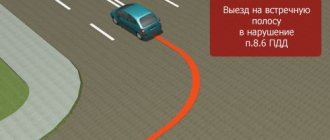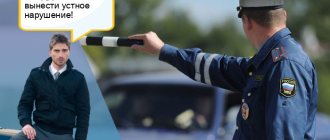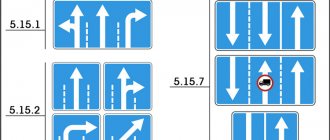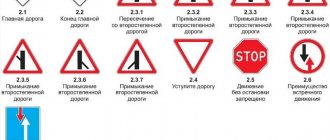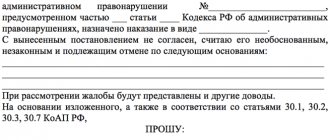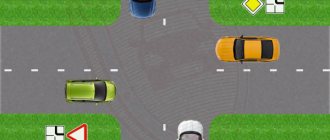Good afternoon, dear reader. In the current age of modern technology, when developing cities strive to cover the entire territory with video surveillance systems and create safer living conditions for ordinary citizens, there remains the other side of this event, this is the automatic recording of administrative offenses by structural divisions of the Russian Ministry of Internal Affairs.
Today I propose to thoroughly understand such notorious moments as passing a “stop line” or a “stop” road sign.
Picture of a “Stop” road sign (“Driving without stopping is prohibited”)
Why do we need a stop line and a stop sign?
Let's start with the understanding that “stop lines” and a “stop” road sign are vital for us, because pedestrians and other motorists need space to cross the road, and besides, visibility for such a maneuver is significantly reduced when a pedestrian looks out from behind a standing route taxi at the pedestrian crossing. There is a huge risk that a car is moving in the opposite direction.
Surely each of the readers has seen or knows stories where people suffered in a similar situation, they suffered significant harm to their health, experienced severe emotional shock, spent money on expensive medications, and often even died as a result of such accidents. In such a situation, it does not matter whether the pedestrian or the driver was right. An indirect role in this tragedy was played by the driver who passed the stop line and did not leave free space for other road users to see.
Therefore, even when you have crossed the stop line, do not continue driving; you should not take risks and create dangerous life situations for others.
And again, the “stop line”, when used correctly, plays a significant role in regulating traffic flows, namely in front of an intersection where every car is randomly jostling, the traffic jam indicator is much higher, in contrast to an intersection where drivers do not start moving and leave the intersection clear until there is free space for their direction of movement.
Controversial situations and filing an appeal
Controversial situations most often arise when a violation is recorded by a camera. Among the most common controversial situations, it is worth highlighting the moment when the markings are crossed by the bumper, but not by the wheels. It also happens that there is a large shadow in the photo that can be mistaken for car wheels. The driver has every right to file an appeal, and the procedure itself is implemented in the following order:
- Collection of evidence, which may include witness statements or photographs from a camera. Try to collect as many facts as possible in your favor.
- File an appeal in your local civil court within 10 days of receiving the penalty notice in the mail.
In addition to the controversial situations discussed at the beginning, cases may be as follows:
- If the driver drove beyond the stop line at a yellow light, penalties will also follow. The yellow signal does not allow movement and belongs to the prohibiting category.
- Hitting a marking and reversing. In fact, a violation took place, but it will only be registered if an oversight on the part of the driver was recorded by a camera or a traffic police officer.
- There is no uniform standard regarding the distance from the marking to the regulated section of the road. The distance itself varies within 0.5 - 1.5 m, therefore, the driver himself may not notice how he crosses the line if it has become erased over time. In such a situation, a fine will still be issued, but the driver has every chance to challenge it in court. It is enough to simply prepare detailed photographs of the questionable section of the road.
This is interesting: Tuning Mercedes Gelendvagen with photo
A few numbers about the location of markings and signs
Now a few words about fulfilling the requirement to stop at the Stop Line. Marking 1.12 or sign 6.16 “Stop line” is a place (line) on the roadway in front of which the driver must stop when further movement is prohibited (at a prohibiting traffic light signal or a traffic controller’s gesture and at the request of sign 2.5 “Driving without stopping is prohibited”
Legal consultation
Get qualified help right now! Our lawyers will advise you on any issues out of turn!
To get a consultation
Thus, when there is a 1.12 marking on the roadway or there is a 6.16 sign, you need to stop in front of the stop line (before the 6.16 sign). More precisely, according to traffic rules, you need to stop at a stop sign not on the line, but in front of the line. Photo and video recording cameras should record the crossing of the stop line not by the front wheels, but by the front bumper of the car, i.e. its protruding part. Crossing (driving) the stop line, or going beyond the stop line at a prohibiting signal entails sanctions under Article 12.12. Part 2 of the Administrative Code.
If a stop sign is installed without a stop line marking, then it is placed at the distances specified in GOST for this marking:
- 10 - 20m from traffic lights when they are located above the roadway,
- and 3 - 5 m from traffic lights when they are located on the side of the roadway.
The numbers are given so that you can imagine the dimensions of the intersection of the roadways of the intersection.
In clause 6.16 of the Traffic Regulations of the Russian Federation it is established that it indicates the place where vehicles stop when there is a prohibitory signal from a traffic light (traffic controller). The driver is required to stop in front of the stop line or the sign itself, if there is none.
Often, due to difficult climatic conditions, poor-quality materials and non-compliance with technology, the applied stop line markings become poorly visible or become completely unusable.
It is important to remember that the traffic rules state:
- A temporary sign is more important than all elements of road construction.
- If a sign contradicts the markings, including temporary ones, or when they are not sufficiently distinguishable, then the sign is more important.
- In cases where permanent marking lines and temporary marking lines contradict each other, drivers must be guided by the meaning of the temporary markings.
- Temporary markings take precedence over permanent markings.
Thus, it became clear to you and me that in cases where the markings are located before the stop sign, there is no violation and the imposed offense can be appealed.
Intersection rules
Incorrect crossing of the stop line occurs in two cases: either the driver is not familiar with the traffic rules, or the traffic within the city is too intense and difficult. In fact, the algorithm of actions on the part of the driver is extremely simple: the movement must be stopped immediately as soon as the stop line is under the hood of the car.
If the driver does not have a good sense of the dimensions of his own car, he must stop as soon as the markings disappear from view. This method is universal among beginners.
If the driver stops correctly, the view of the traffic light located above the road will be completely open - this is what the markings are designed for. In order not to receive a fine for crossing the stop line, it is worth analyzing all the conditions for placing the markings in question:
- If a stop line is placed at a controlled pedestrian crossing, it is necessary to stop only when this is indicated by the actions of the traffic controller or a red traffic light. In other cases, you can freely cross the line.
- At a controlled intersection the situation is similar.
- If the intersection is unregulated, there must be a “STOP” sign; therefore, the driver stops and makes sure that his vehicle does not interfere with other road users.
- If we are talking about a controlled railway intersection, the procedure is similar to the first point.
- Driving through an unregulated railway intersection is regulated by the same rules as point 3.
This is interesting: What is needed to deregister a car, how to do it correctly
Rules for driving under the stop control sign
Sign 3.17.3 - Control
It is worth noting that it is necessary to distinguish the stop sign from the control stop sign, which is enshrined in clause 3.17.3 of the Russian Traffic Regulations, which states that it prohibits driving through checkpoints without stopping. The sign is also installed on toll roads in front of the toll booth; in this case it is used with a sign.
This sign is quite rare, for example near:
- Traffic police posts;
- border zones;
- quarantine posts;
- entrances to closed areas.
However, the actions of the driver are not very different from the actions when there is a sign “driving without stopping is prohibited”: the sign “driving without stopping is prohibited” means that you need to stop in front of the sign, but you can continue to follow your route only after all the steps have been completed. procedures provided for by law and the Traffic Rules (checking documents, inspecting or inspecting vehicles, etc.), and naturally, after the appropriate permission from the checkpoint officer.
Important!
You should not treat this sign carelessly, because... if there are legal grounds for the presence of this sign, the security forces even have the authority to open fire on your car, but most likely they are conducting a special operation or guarding a sensitive facility and by your actions you are formally committing another administrative offense - disobedience to the legal request of a government official, so remember that the sign requires a mandatory stop.
Daily meetings with auto-fixation cameras
The main thing to understand here is that the auto-fixing camera is a weak-willed machine, into which several coordinates have been driven in, creating a straight line, beyond which you cannot drive when the traffic light turns on, and a simple algorithm for performing this action has been established. Regardless of the situation on the road, she will perform the task assigned to her.
You can go to the traffic light, but stay behind the stop line and not get to the intersection due to a traffic jam. And as soon as the prohibitory traffic light comes on, the camera has faithfully recorded your offense.
You can start driving on a yellow (prohibiting) traffic light, but you will still receive an administrative fine.
There are also cases when, due to repair work, the traffic light is turned off, but the auto-fixation camera does its job properly here too.
Often in life there are cases when a stop sign is installed on a four-lane road under a traffic light. From the fourth lane it is practically invisible due to the car standing next to it. It is quite unsafe to drive in the fourth lane and look to the far right lane for a stop sign.
In accordance with GOST, the stop sign is installed to the right of the road or above the roadway. It is permissible to install a sign above each traffic lane, i.e. GOST specifies the location of the sign to ensure its better visibility. Why they don’t do it is a complicated question. You must write a statement to the traffic police department
It should also be said that when a three-color traffic light is switched to a yellow flashing signal, the section of the road that this traffic light regulates becomes unregulated. In this case, there is no need to stop at the stop line.
If it is necessary to give way (for example, at an uncontrolled intersection or an unregulated pedestrian crossing), it is enough to stop the car on the roadway in such a way that priority is respected.
In any case, carefully monitor the traffic situation and make timely decisions to appeal administrative offenses received through auto-recording cameras.


